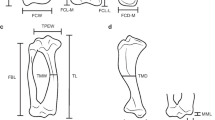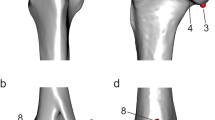Abstract
Metapodials and phalanges of the second to fourth digital ray were measured for the hands and feet of 214 specimens belonging to 45 extant species of hystricognath rodents, encompassing members of all major clades of the radiation. Principal components analysis (PCA), the phalangeal index of the third digital ray in the hands and feet, and the relationship between second and fourth digital ray were used to investigate intrinsic autopodial proportions as well as to provide a base for comparisons between hands and feet. PCA separated cursorial Hystricognathi from arboreal ones, but lead to little distinction in other locomotory modes. Cursors have longer metapodials and shorter phalanges, particularly in their hind limb, while arboreal species have relatively longer manual and pedal phalanges. Terrestrial, scansorial, fossorial, and semi-aquatic species were not clearly distinguished, but there is a tendency towards elongated manual digits and relatively short feet in most fossorial species. Closely related species with similar locomotory habits tend to group together in PCA morphospace, and also have similar phalangeal indices. The results are in agreement with current hypotheses on locomotory adaptations of the hand and foot, and concur with many previous findings on autopodial proportions in arboreal, cursorial, and fossorial species. They also highlight the limited use of autopodial proportions for inferring systematic affinities. The lack of distinction in the majority of species is likely related to the lack of highly specialized locomotory types in Hystricognathi. r 2006 Deutsche Gesellschaft für Säugetierkunde. Published by Elsevier GmbH. All rights reserved.
Zusammenfassung
Die Länge der Hand/Fußmetapodien und Fingerelemente des zweiten bis vierten Hand-und Fußstrahles wurden bei 214 Individuen aus 45 rezenten Arten der hystricognathen Nager vermessen, wobei alle größeren Stämme vertreten waren. Um die Diversität der Autopodienproportionen vergleichend darzustellen, wurden jene Elemente, die vor allem an der Diversität in hystricognathen Autopodien beteiligt sind, durch Principal Components Analysis (PCA) ermittelt. Außerdem wurden der “Phalangeal index” des dritten Hand-und Fußstrahles sowie das Verhältnis des zweiten und vierten Hand- und Fußstrahles zueinander bestimmt.
Die PCA trennte vor allem die kursorialen Hystricognathi von den arborealen. Erstere haben besonders im Fuß längere Metapodien und relativ kurze Fingerelemente, arboreale Arten zeichnen sich durch längere Fingerelemente und dementsprechend relativ kürzere Metapodien aus.
Alle anderen Lokomotionskategorien (terrestrisch, skansorial, fossorial, und semi-aquatisch) konnten von keiner Methode eindeutig voneinander getrennt werden, obwohl stark fossoriale Tiere zu verlängerten Fingern und insgesamt kürzeren Füßen tendieren. Nah verwandte Arten mit ähnlichen Lokomotionsgewohnheiten sind im PCA - Diagramm oft gruppiert und ähneln einander auch in ihren “Phalangeal indices”. Die Verhältnisse der Finger-und Fußstrahlen zueinander sind nicht besonders informativ abgesehen von der Entaxonie einiger grabender Bathyergidae und Ectaxonie von Kannabateomys. Unsere Ergebnisse stimmen mit den gängigen Hypothesen über Anpassungen an arborealen, kursorialen, und grabenden Lokomotionstypen überein und decken sich mit vielen Ergebnissen von anderen Säugergruppen. Somit weisen sie auch auf die bedingte Nützlichkeit von Handproportionen in Bezug auf systematische überlegungen hin. Die geringe Abgrenzung von Arten verschiedener lokomotorischer Gewohnheiten ist wahrscheinlich darauf zurückzuführen, daß die meisten Hystricognathi relativ unspezialisiert und meist zu mehreren Lokomotionstypen fähig sind.
Similar content being viewed by others
References
Allard, M. W.; Honeycutt, R. L. (1992): Nucleo-tide sequence variation in the mitochondrial 12S rRNA gene and the phylogeny of African mole-rats (Rodentia: Bathyergidae). Mol. Biol. Evol. 9, 27–40.
Badoux, D. M. (1974): An introduction to biome-chanical principles in primate locomotion and structure. In: Primate Locomotion. Ed. by F. A. Jenkins. New York: Academic Press. Pp. 1–43.
Barbosa, O. R.; Renous, S.; Gasc, J.-P. (1996): Adaptation a la course chez le cobaye Cavia porcellus (Mammifere, rongeur, caviomorphe). Bull. Soc. Zool. Fr. 121, 115–117.
Biewener, A. A. (2002): Future directions for the analysis of musculoskeletal design and locomo-tor performance. J. Morph. 252, 38–51.
Biknevicius, A. R. (1993): Biomechanical scaling of limb bones and differential limb use in caviomorph rodents. J. Mammalogy 74, 95–107.
Bloch, J. I.; Boyer, D. M. (2002): Grasping primate origins. Science 298, 1606–1610.
Bryant, J. D.; Bennett, M. B.; Brust, J.; Alexander, R. M. (1987): Forces exerted on the ground by galloping dogs (Canis familiaris). J. Zool. (London) 213, 193–203.
Candela, A. M. (2001): First cladistic analysis of the extinct and living porcupines (Rodentia, Erethizontidae). J. Morph. 248, 213.
Cartmill, M. (1985): Climbing. In: Functional Vertebrate Morphology. Ed. by M. Hildebrand, D. M. Bramble, K. F. Liem, D. B. Wake. Cambridge, Massachusetts: Belknop Press. Pp. 73–88.
Christiansen, P. (1999): Scaling of the limb long bones to body mass in terrestrial mammals. J. Morph. 239, 167–190.
De Graaff, G. (1981): The rodents of Southern Africa. Durban: Butterworth and Co.
Dubost, G. (1968): Les mammiferes souterrains. Rev. Ecol. Biol. Sol. 1, 99–133.
Eisenberg, J. F. (1989): Mammals of the Neotro-pics. Vol. I. The Northern Neotropics. Chicago: The University of Chicago Press.
Eisenberg, J. F.; Redford, K. H. (1999): Mammals of the Neotropics. Vol. III. The Central Neotropics. Chicago: The University of Chicago Press.
Elissamburu, A.; Vizcaíno, S. F. (2004): Limb proportions and adaptations in caviomorph rodents (Rodentia: Caviomorpha). J. Zool. (London) 262, 145–159.
Etter, H. -U. (1974): Morphologisch- und metrischvergleichende Untersuchung am Handskelet rezenter Primaten Teil IV. Gegenbaurs Morph. Jb. 120, 457–484.
Fischer, M. S.; Schilling, N.; Schmidt, M.; Haarhaus, D.; Witte, H. (2002): Basic limb kinematics of small therian mammals. J. Exp. Biol. 205, 1315–1338.
Fish, F. (1994): Transitions from drag-based to lift-based propulsion in mammalian swimming. Aust. J. Zool. 42, 79–101.
Flynn, J. J.; Wyss, A. R. (1998): Recent advances in South American mammalian palaeontology. Trends Ecol. Evol. 13, 449–454.
Garland Jr., T.; Janis, C. M. (1993): Does metatarsal/femur ratio predict maximal running speed in cursorial mammals? J. Zool. (London) 229, 133–151.
Ginsburg, L. (1961): Plantigradie et digitigradie chez les carnivores fissipedes. Mammalia 25, 1–21.
Grand, T. I.; Eisenberg, J. F. (1982): On the affinities of the Dinomyidae. Saugetierkundl. Mitt. 30, 151–157.
Grzimek, B. (1988): Grzimeks Enzyklopadie der Saugetiere. Vol. 3. Munich: Kindler Verlag.
Hamrick, M. W.; Rosenman, B. A.; Brush, J. A. (1999): Phalangeal morphology of the Paromo-myidae (Primates, Plesiadapiformes): the evidence for gliding behavior reconsidered. Am. J. Phys. Anthropol. 109, 397–413.
Heffner, R.; Masterton, B. (1975): Variation in form of the pyramidal tract and its relationship to digital dexterity. Brain Behav. Evol. 12, 161–200.
Hildebrand, M. (1985): Digging of quadrupeds. In: Functional Vertebrate Morphology. Ed. by M. Hildebrand, D. M. Bramble, K. F. Liem, D. B. Wake. Cambridge, Massachusetts: Belknop Press. Pp. 89–109.
Hildebrand, M. (2001): Analysis of Vertebrate Structure. 5th ed. New York: John Wiley and Sons.
Honeycutt, R. L.; Rowe, D. L.; Gallardo, M. H. (2003): Molecular systematics of South American caviomorph rodents: relationships among species and genera in the family Octodontidae. Mol. Phylogenet. Evol. 26, 476–489.
Huchon, D.; Douzery, E. J. P. (2001): From the old world to the new world: a molecular chronicle of the phylogeny and biogeography of hystricognath rodents. Mol. Phylogenet. Evol. 20, 238–251.
Iwaniuk, A. N.; Pellis, S. M.; Whishaw, I. Q. (2001): Are long digits correlated with high forepaw dexterity? A comparative test in terrestrial carnivores. Can. J. Zool. 79, 900–906.
Ji, Q.; Luo, Z. -X.; Yuan, C. -X.; Wible, J. R.; Zhang, J. -P.; Georgi, J. A. (2002): The earliest known eutherian mammal. Nature 416, 816–822.
Jouffroy, F. K.; Godinot, M.; Nakano, Y. (1993): Biometrical characteristics of primate hands. In: Hands of Primates. Ed. by H. Preuschoft, D. J. Chivers. Wien: Springer. Pp. 133–171.
Jungers, W. L.; Falsetti, A. B.; Wall, C. E. (1995): Shape, relative size, and size-adjustments in morphometrics. Yrbk. Phys. Anthropol. 38, 137–161.
Jungers, W. L.; Lemelin, P.; Godfrey, L. R.; Wunderlich, R. E.; Burney, D. A.; Simons, E. L.; Chatrath, P. S.; James, H. F.; Randria, G. F. N. (2005): The hands and feet of Archae-olemur: metrical affinities and their functional significance. J. Hum. Evol 49, 36–55.
Lammers, A. R.; Dziech, H. A.; German, R. Z. (2001): Ontogeny of sexual dimorphism in Chinchilla lanigera (Rodentia: Chinchillidae). J. Mammalogy 82, 179–189.
Lemelin, P. (1999): Morphological correlates of substrate use in didelphid marsupials: implications for primate origins. J. Zool. (London), 247, 165–175.
Lessertisseur, J.; Jouffroy, F. K. (1973): Tendances locomotrices des primates traduites par les proportions du pied. Folia Prim. 20, 125–160.
Luo, Z. -X.; Wible, J. R. (2005): A late jurassic digging mammal and early mammalian diversification. Science 308, 103–107.
Luo, Z. -X.; Crompton, A. W.; Sun, A. -L. (2001): A new mammaliaform from the early Jurassic and evolution of mammalian characteristics. Science 292, 1535–1540.
Martin, T. (1994): African origin of caviomorph rodents is indicated by incisor enamel micro-structure. Paleobiology 20, 5–13.
McKenna, M. C.; Bell, S. K. (1997): Classification of Mammals above the Species Level. New York: Columbia University Press.
Napier, J. R. (1961): Prehensility and opposability in the hands of primates. Symp. Zool. Soc. (London) 5, 115–133.
Napier, J. R. (1993): Hands. Princeton, N.J.: Princeton University Press.
Nowak, R. M. (1999): Walker’s Mammals of the World Vol. II. 6th ed. Baltimore: Johns Hopkins University Press.
Pocock, R. I. (1922): On the external characters of some hystricomorph rodents. Proc. Zool. Soc. (London) 25, 365–427.
Preuschoft, H.; Godinot, M.; Beard, K. C.; Nieschalk, U.; Jouffroy, F. K. (1993): Biome-chanical considerations to explain important morphological characters of primate hands. In: Hands of Primates. Ed. by H. Preuschoft, D. J. Chivers. Wien: Springer. Pp. 245–256.
Ray (1958): Fusion of cervical vertebrae in the Erethizontidae and Dinomyidae. Brev. Mus. Comp. Zool. Harvard Univ. 91, 1–11.
Redford, K. H.; Eisenberg, J. F. (1992): Mammals of the Neotropics, The Southern Cone. Vol. II. Chicago and London: The University of Chicago Press.
Rowe, D. L.; Honeycutt, R. L. (2002): Phyloge-netic relationships, ecological correlates, and molecular evolution within the Cavioidea (Mammalia, Rodentia). Mol. Biol. Evol. 19, 263–277.
Sanchez-Villagra, M. R.; Aguilera, O.; Horovitz, I. (2003): The anatomy of the world’s largest extinct rodent. Science 301, 1708–1710.
Smith, K. K.; Redford, K. H. (1990): The anatomy and function of the feeding apparatus in two armadillos (Dasypoda): anatomy is not destiny. J. Zool. (London) 222, 27–47.
Steudel, K.; Beattie, J. (1995): Does limb length predict the relative energetic cost of locomotion in mammals? J. Zool. (London) 235, 501–514.
Strasser, E. (1992): Hindlimb proportions, allome-try, and biomechanics in Old World monkeys (Primates, Cercopithecinae). Am. J. Phys. Anthr. 87, 187–213.
Taylor, M. E. (1974): The functional anatomy of the forelimb of some African Viverridae (Car-nivora). J. Morph. 143, 307–336.
Van Valkenburgh, B. (1987): Skeletal indicators of locomotor behavior in living and extinct carnivores. J. Vert. Paleontol. 7, 162–182.
Walker, A. C. (1974): Locomotor adaptations in past and present prosimian primates. In: Primate Locomotion. Ed. by F. A. Jenkins. New York: Academic Press. Pp. 349–381.
Walton, A. H.; Nedbal, M. A.; Honeycutt, R. L. (2000): Evidence from intron 1 of the nuclear transthyretin (Prealbumin) gene for the phylo-geny of African mole-rats (Bathyergidae). Mol. Phylogenet. Evol. 16, 467–474.
Weir, B. J. (1974): The tuco-tuco and plains viscacha. Symp. Zool. Soc. (London) 34, 113–130.
Witte, H.; Biltzinger, J.; Hackert, R.; Schilling, N.; Schmidt, M.; Reich, C.; Fischer, M. S. (2002): Torque patterns of the limbs of small therian mammals during locomotion on flat ground. J. Exp. Biol. 205, 1339–1353.
Woods, C. A.; Contreras, L.; Willner-Chapman, G.; Whidden, H. P. (1992): Myocastor coypus. Mammalian species 398, 1–8.
Woods, C. A.; Hermanson, J. W. (1985): Myology of hystricognath rodents: An analysis of form, function, and phylogeny. In: Evolutionary Relationships among Rodents: A Multidisci-plinary Analysis. Ed. by W. P. Luckett, J. -L. Hartenberger. New York: Plenum Press. Pp. 515–548.
Author information
Authors and Affiliations
Corresponding author
Rights and permissions
About this article
Cite this article
Weisbecker, V., Schmid, S. Autopodial skeletal diversity in hystricognath rodents: Functional and phylogenetic aspects. Mamm Biol 72, 27–44 (2007). https://doi.org/10.1016/j.mambio.2006.03.005
Received:
Accepted:
Published:
Issue Date:
DOI: https://doi.org/10.1016/j.mambio.2006.03.005




